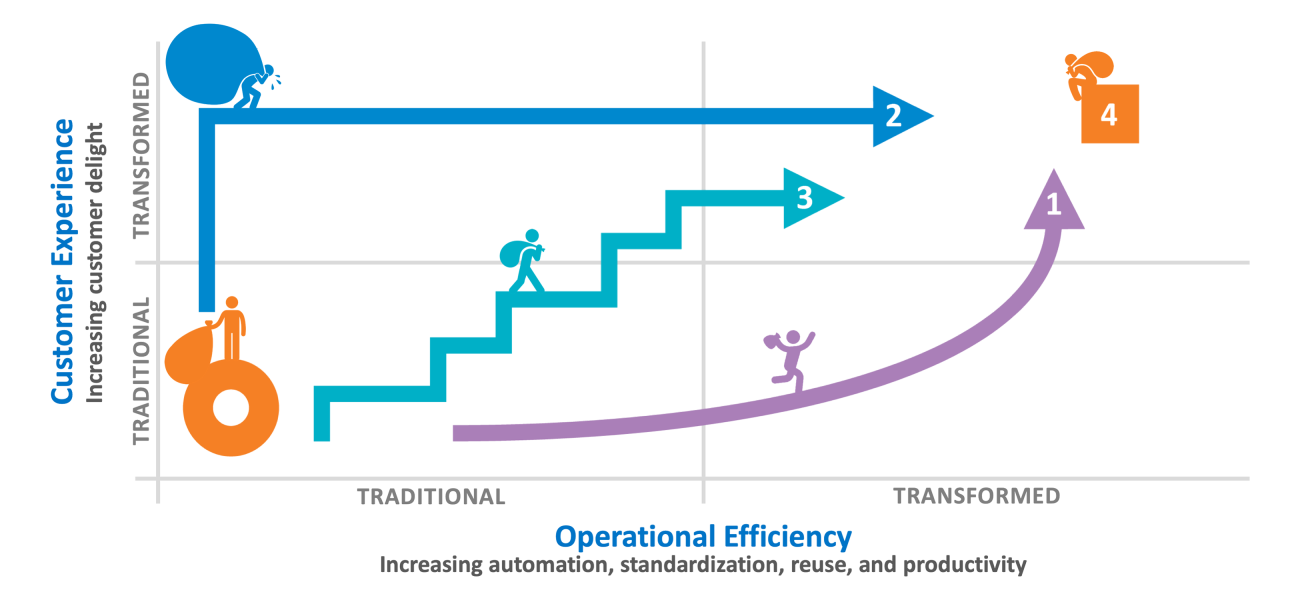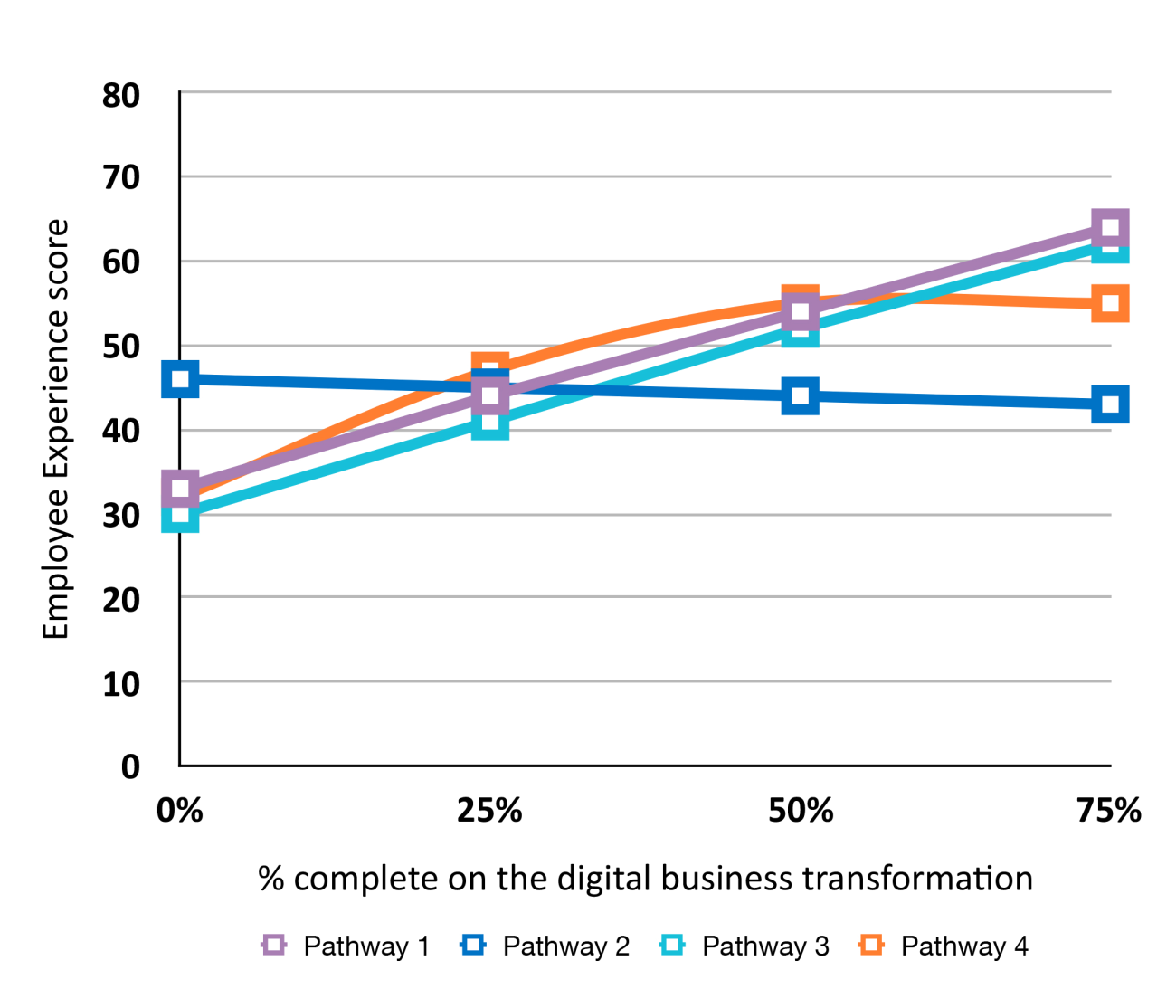Digital business transformation calls for ambidexterity: companies aim to delight customers with new innovations and offerings while simultaneously reducing costs. This is no easy feat, as it requires developing new operational and customer-oriented capabilities. Senior leaders expect that these transformation efforts will (on average) significantly affect 67 percent of employees.[foot]Based on the answers of respondents to the MIT CISR 2017 Pathways to Digital Business Transformation survey (N=413).[/foot] After all, it’s employees who have to adopt new systems, data, processes, and habits to deliver on the transformation[foot]The four pathways to digital business transformation are described in P. Weill, N. van der Meulen, and S. L. Woerner, “Becoming Future Ready Requires Organizational Explosions,” MIT Sloan CISR Research Briefing, Vol. XVIII, No. 8, August 2018, https://cisr.mit.edu/publication/2018_0801_pathwaysexplosions_weillvandermeulenwoerner.[/foot] (see figure 1), which are distinguished by the order in which a company develops operational and customer-oriented capabilities. This order significantly influences the work complexity that employees face, which is a key determinant of a company’s employee experience and a leading indicator of future company performance.[foot]We define employee experience as the extent to which employees of an organization are enabled or constrained by its adaptive work environment and collective work habits to do their jobs today and reimagine their jobs of tomorrow. For more on this definition and related findings, see K. Dery, N. van der Meulen, and I. M. Sebastian, “Employee Experience: Enabling Your Future Workforce Strategy,” MIT Sloan CISR Research Briefing, Vol. XVIII, No. 9, September 2018, https://cisr.mit.edu/publication/2018_0901_digitaltalent_deryvandermeulensebastian. We performed employee experience analyses on a subset of respondents (N=301) to the MIT CISR 2017 Pathways to Digital Business Transformation survey (N=413). The subset was composed of companies that had provided employee experience data.[/foot] While near-simultaneous development of operational and customer-oriented capabilities (represented by Pathway 3) would seem the most challenging to employees, we instead found it is when companies prioritize developing customer-oriented capabilities over operational capabilities (as on Pathway 2) that work complexity increases.

The Employee Experience of Digital Business Transformation
Abstract
MIT CISR research has shown that senior leaders expect that digital transformation efforts will significantly affect 67 percent of employees. After all, it’s employees who have to adopt new systems, data, processes, and habits to deliver on the transformation. This briefing outlines just how employees are affected, by describing the employee experience along four distinct transformation pathways. We found that employees suffer from increased work complexity when companies follow pathways that prioritize developing customer-oriented capabilities over operational capabilities. Companies can improve their employee experience by first developing a foundation of required operational capabilities, or by doing so in small iterations by alternating with corresponding customer-oriented capabilities.

Figure 1: The Four Pathways to Future Ready
Pathway lines are based on a series of informal interviews (conducted between 2015 and 2017) on digital transformation with senior executives globally; the lines were confirmed via the MIT CISR 2017 Pathways to Digital Business Transformation survey (N=413). The people depicted on each pathway illustrate the relative level of work complexity that employees face, which negatively affects the employee experience.
The Employee Experience in Becoming Future Ready
The goal of digital business transformation is for a company to become “Future Ready”: to develop operational and customer-oriented capabilities that enable the company to become more agile, make data a strategic asset, and partner to participate in digital ecosystems. In terms of new operational capabilities, companies strive for efficiency (1) by automating, standardizing, and reusing core processes through modularized services; (2) by integrating and renewing digital infrastructure; and (3) by providing company stakeholders with seamless access to systems and disparate sources of data (to serve as a single source of truth). With customer-focused capabilities, the goal is to delight the customer, requiring companies to (1) integrate customer offerings across multiple products and channels, (2) collect quality customer information (including customer concerns, needs, and goals), and (3) create new value propositions that are distinctive and make the company the first place customers think of when a need arises.
To examine how developing these two types of capabilities impacts the employee experience, we compared companies at different stages of (self-reported) transformation progress along each pathway. Figure 2 summarizes how the observed employee experience ratings changed according to the percentage of the transformation that companies had completed, and how these changes differed between pathways.

Figure 2: The Employee Experience Along Each of the Four Pathways
Based on an employee experience-focused subset of respondents (N=301) to the MIT CISR 2017 Pathways to Digital Business Transformation survey (N=413). The percentage complete value indicates how far along a company is in its digital business transformation to a Future Ready state. Employee experience was calculated using a mean scale on responses to six questions on adaptive work environment and five on collective work habits (measured on a five-point scale) and converted to a 0–100 score.
Pathway 1: Industrialized Foundations Reduce Complexity
Companies near the start of Pathway 1 couple measuring the cost of operations with the standardization, integration, and reuse of best-in-class processes, data, and technology. This strips away some administrative activities and simplifies work, allowing employees to deliver a better customer experience. This process is later reinforced by improvements in measuring customer sentiment and Net Promoter Score (NPS), enabling employees to better understand customer needs and contribute to ideas for new offerings.
Once Pathway 1 companies become more Future Ready, they increasingly rely on the ability to leverage the benefits of organizing and participating in business ecosystems. To support the formation of new ecosystem revenue streams, these companies tend to further develop their automation and shared services capabilities, along with building new work habits that support the success of recent acquisitions and partnerships. We found that such capabilities make it easier for employees to search for expertise within the company, share ideas, and actively seek ways to deliver multiproduct, multichannel customer experiences.
Pathway 2: Customer-Centricity Requires Heroics
Pathway 2 companies can’t wait to improve their customer experience and therefore prioritize developing customer-oriented capabilities over operational capabilities. As such, we found companies at the start of this pathway work on gathering great customer information to amplify the voice of the customer inside the company and develop an integrated customer experience. But without the required operational capabilities, companies typically have to rely on external vendors, suppliers, or newly acquired companies to support such customer-focused efforts. This dependence on external parties (along with an intense focus on the customer) comes at the expense of employees, who find it difficult to develop, share, and contribute their own ideas that might benefit the company.
Those companies in our survey that are more advanced along Pathway 2 appear to struggle with keeping momentum in their customer-oriented capability development. On many operational capabilities (such as measuring the cost of operations and renewing digital infrastructure) they are even rated as less effective than counterparts that have just started the transformation journey. The result is that employees increasingly have to resort to heroics to deliver value. Leaders, for instance, ask employees to become more evidence based, but it’s hard to predict customer behavior when company systems and data are stuck in "silos and spaghetti."
It is not until Pathway 2 companies mature and “turn right” to focus on building operational capabilities that they become more effective at identifying customer concerns and developing new distinctive value propositions. When a company automates core processes and provides seamless access across systems and disparate sources of data, employees can become better informed and able to anticipate and predict customer needs. Yet we find that despite these operational improvements, the employee experience remains problematic and rated well below average. Decision making is slow, and employees typically face low autonomy in deciding when, where, and how to do their work. The singular focus on creating an environment in which the customer is placed above all else has become thoroughly ingrained in employee work habits, and changing these habits for the better will require significant decision rights changes going forwards.
Pathway 3: Iterations Enable Employee Learning
When companies pursue multiple smaller initiatives to develop their operational and customer-oriented capabilities iteratively, they follow the third pathway. Early stage Pathway 3 companies typically have a broad focus when developing capabilities. We found that among the top priorities for these companies are integrating operations across silos, providing employees with seamless access to systems and data, and automating and standardizing core processes through modularized services. These capabilities reduce operational complexity, making it easier for employees to become more evidence based and to integrate customer offerings across multiple products and channels.
After experimenting with different practices, Pathway 3 companies mostly focus on further standardization and reuse. Employees are not as held up by overhead and are far more likely to approach colleagues at any level of the company due to greater levels of autonomy. Companies leverage this autonomy later in the transformation journey, when they become effective at measuring the cost of operations and the customer experience (using NPS or similar measures). Dashboards democratize access to metrics, and combined with habits of increased transparency, encourage employees to become more open and curious. Simplified systems help employees make more informed contributions to ideas for new products and services across the company.
Pathway 4: New Company, Not Necessarily Nirvana
Companies along Pathway 4 opt to develop the necessary capabilities in a digitally born company, rather than deal with fixing the silos and spaghetti. Our survey data shows that—with an average of over a third of company revenues coming from business ecosystems—early stage companies on this pathway typically work on the identification and development of acquisitions. A new digital infrastructure supports roles and ways of working that make it easy to serve the customer. Add into the mix the energy and opportunities involved in starting a new company, and we find employees enjoy a work environment that is collaborative and innovative. The pain returns, however, once Pathway 4 companies shift their focus to primarily developing customer-oriented capabilities in order to continue to thrive in business ecosystems. Work complexity becomes problematic for employees without development of supporting operational capabilities. The focus on growth catches up with these companies, and we see employees challenged, particularly in areas such as work autonomy, connecting to systems, and dealing with administrative tasks.
Heroics Can't Deliver Sustained Value
The order in which companies develop operational and customer-oriented capabilities has a significant impact on the employee experience. We found that while a singular focus on the customer may deliver revenue growth and positive customer feedback, it is tough on employees. Over time, the mounting technical debt impedes customer-oriented capability development to such an extent that heroics can no longer deliver expected operational and customer value.
Companies should thus first develop a foundation of required operational capabilities, or do so in small iterations by alternating with customer-oriented capabilities. While these approaches both benefit the employee, it is important to recognize that the employee experience requires deliberate attention. Companies that have progressed on Pathways 1 and 3 primarily drive their transformation from within, recognizing that this approach affects most of their employees. They consider the employee experience (very) important to the future success of their company and pay greater attention to the role of the employee in delivering value.[foot]Approximately 70 percent of the Pathway 1 and 3 companies in our survey considered improving the employee experience (very) important to future enterprise success, compared to 51 percent of companies on Pathway 2 and 67 percent on Pathway 4.[/foot] Our data on the employee experience along each of these pathways is ultimately a stark reminder that enabling employees to do their jobs to the very best of their capabilities requires the constant focus of leaders. Heroics from committed employees are neither scalable nor sustainable.
© 2020 MIT Sloan Center for Information Systems Research, Van der Meulen and Dery. MIT CISR Research Briefings are published monthly to update the center's patrons and sponsors on current research projects.
About the Authors
MIT CENTER FOR INFORMATION SYSTEMS RESEARCH (CISR)
Founded in 1974 and grounded in MIT's tradition of combining academic knowledge and practical purpose, MIT CISR helps executives meet the challenge of leading increasingly digital and data-driven organizations. We work directly with digital leaders, executives, and boards to develop our insights. Our research is funded by member organizations that support our work and participate in our consortium.
MIT CISR Associate Members
MIT CISR wishes to thank all of our associate members for their support and contributions.





